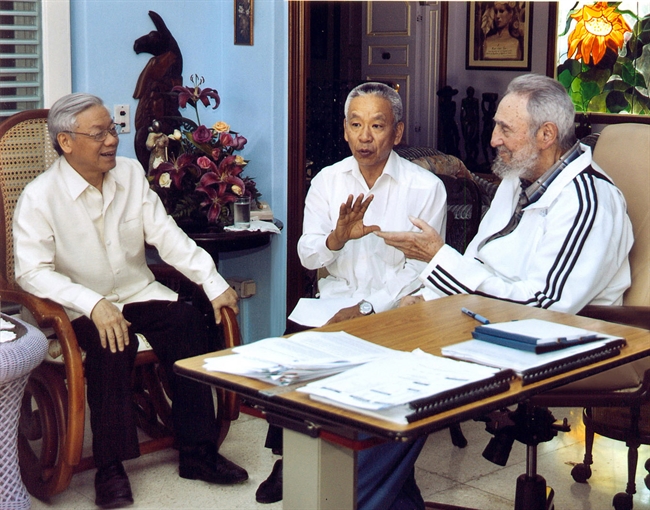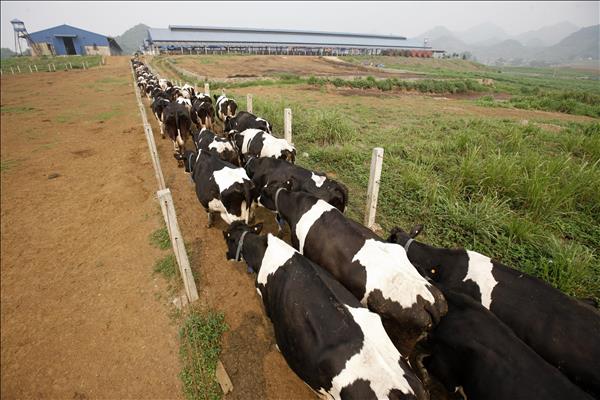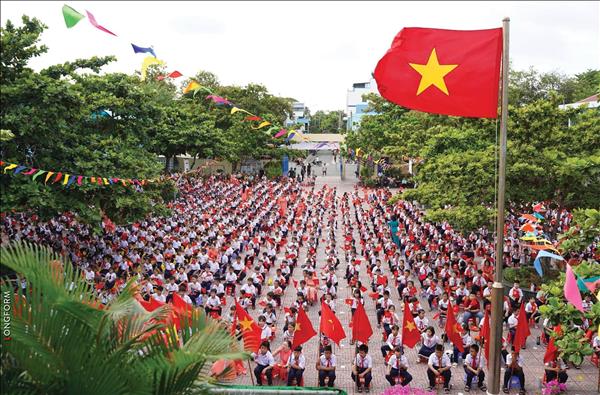Cuban revolutionary leader Fidel Castro, a towering figure of the 20th century, passed away at 22:29 in Havana on November 25 at the age of 90, a huge loss for the Communist Party of Cuba and the fraternal State and people of Cuba but also the international movement for communist revolution.
For decades, Fidel Castro had been a symbol of revolutionary heroism, spirit of undaunted struggle and desire for freedom and happiness. The Vietnamese people always keep in mind the image of the Cuban commander with love, admiration and deep sympathy.
In its history, under the leadership of Fidel, Cuba was the pioneer in the movement of supporting Vietnam’s struggle for independence as well as national construction. Cuba was the first country to recognise the National Liberation Front of South Vietnam in September 1963, as well as the first and only to set up its embassy in the front in July 1967.
During that period, Cuba also faced many difficulties. However, during a meeting in Havana with the participation of tens of thousands of people, Fidel Castro stated that “unfortunately, we - Cuban people – do not have enough milk and sugar to send to Vietnamese people. If we did, we would send not only milk and sugar but also our blood”.
In its history, under the leadership of Fidel, Cuba was the pioneer in the movement of supporting Vietnam’s struggle for independence as well as national construction. Cuba was the first country to recognise the National Liberation Front of South Vietnam in September 1963, as well as the first and only to set up its embassy in the front in July 1967.
During that period, Cuba also faced many difficulties. However, during a meeting in Havana with the participation of tens of thousands of people, Fidel Castro stated that “unfortunately, we - Cuban people – do not have enough milk and sugar to send to Vietnamese people. If we did, we would send not only milk and sugar but also our blood”.
Cuban leader Fidel Castro (August 13/1926 – November 25/2016). Photo: EPA/VNA
The year 1976 was named “Heroic Vietnam Year” by Cuba as part of its support to Vietnam. In 1972 when the dyke system in the north of Vietnam was destroyed by the US, Cuba took August 28 as “Dyke Day” and launched a campaign to denounce the crimes of the imperialism.
The leader reaffirmed that “our solidarity with, our trust in the Vietnamese people and leaders is unconditional and absolute.”
In September 1973, Fidel Castro was the first and only foreign leader to visit the southern liberation area of Vietnam when the war was ongoing, bringing a great encouragement to Vietnamese soldiers and people and a promise to help realise President Ho Chi Minh’s wish to build a more prosperous country. This showed the special sentiments of him and the Cuban people towards Vietnam and its national liberation.
The image of the Cuban commander-in-chief, in his olive uniform, standing in an enemy’s blockhouse raising the flag of the National Liberation Front of South Vietnam, became an extremely impressive image and a source of encouragement to Vietnamese people.
Prime Minister Pham Van Dong welcomed Comrade Fidel Castro who visited the liberated zone in sourthern
Viet Nam's Quang Tri Province (September 15, 1973). Photo: VNA

Cuban leader Fidel Castro visits the liberated town of Dong Ha in Quang Tri. Photo: VNA

Cuban leader Fidel Castro visits the Tan Lam and Doc Mieu bases in McNamara Line (Electric Fence). Photo: VNA

Cuban leader Fidel Castro visits the Tan Lam and Doc Mieu bases in McNamara Line (Electric Fence). Photo: VNA

Cuban leader Fidel Castro raises Khe Sanh Battalion’s flag while meeting with liberation soldiers in Quang Tri (Photo: VNA)

Cuban President Fidel Castro and Prime Minister Pham Van Dong and Khe Sanh battalion’s soldiers in Quang Tri. Photo: VNA

General Vo Nguyen Giap and Fidel Castro visited the Vietnam Military History Museum (September 12, 1973). Photo: VNA

Cuban President Fidel Castro and Cuban people welcomed Prime Minister Pham Van Dong in Havana (March 22, 1974). Photo: Minh Dao/VNA

Cuban President Fidel Castro received Prime Minister Vo Van Kiet in Havana. (July 10,1993).Photo: Minh Dao/VNA

Party General Secretary Do Muoi, State President Le Duc Anh and Prime Minister Vo Van Kiet received
Cuban President Fidel Castro during his official visit to Vietnam (December 8-12, 1995). Photo: Minh Dien/VNA

Cuban leader Fidel Castro met the advisor to the Party Central Committee Pham Van Dong (December 8-12, 1995).
Photo: Minh Dien/VNA

Cuban leader Fidel Castro visited Duc Giang Garment Company in Hanoi (December 8-12, 1995). Photo: Minh Dien/VNA

Cuban leader Fidel Castro visited General Vo Nguyen Giap at his house in Hanoi (February 22, 2003). Photo: Nhan Sang/VNA

Cuban leader Fidel Castro visited the University of Science and Technology (February 23, 2003). Photo: Duc Tam/VNA

Cuban leader Fidel Castro received State President Nguyen Minh Triet in Havana (September 28, 2009). Photo: VNA

Party General Secretary Nguyen Phu Trong visited Cuban leader Fidel Castro in Havana (April 11, 2012). Photo: VNA

Cuban leader Fidel Castro received Prime Minister Nguyen Tan Dung and
National Assembly Deputy Chairwoman Nguyen Thi Kim Ngan in Havana ( March 26, 2014). Photo: VNA

Cuban leader Fidel Castro is presented with a portrait of himself by State President Tran Dai Quang
who paid an official visit to Cuba on November 15-17, 2016. Photo: VNA
During the hardest period of the anti-US revolution, when Fidel said “Cuba is willing to devote blood for Vietnam” melted the hearts of the Vietnamese and Cuban people as well as peace-lovers around the world. The Cuban leader and people considered Vietnam’s struggle as their own.
Also in his first visit to Vietnam, Fidel Castro presented Vietnam with five important socio-economic works worth about 80 million dollars, including Thang Loi Hotel in Hanoi, Vietnam-Cuba Hospital in Quang Binh, Xuan Mai Road, Ba Vi cow breeding farm, and a Luong My chicken factory. He also gave Vietnam help in breeding cows or chickens, along with more than 6 million dollars for buying modern production equipment. At the same time, Cuba also sent experts to Vietnam to help in the construction of the Ho Chi Minh Trail and trained more than 1,000 Vietnamese university students and post-graduates. Cuba also supported Vietnam in joining the United Nations.

On November 28, 2016, leaders of the Party, State and Government of Vietnam paid homage to Cuban leader Fidel Castro at the
Cuban Embassy in Hanoi. In the photo: Party General Secretary Nguyen Phu Trong shared the loss with
Cuban Ambassador Herminio Lopez Diaz. Photo: Tri Dung/VNA

State President Tran Dai Quang presents his condolences to Cuban Ambassador Herminio Lopez Diaz. Photo: Doan Tan/VNA

Prime Minister Nguyen Xuan Phuc writes in the funeral book at the Cuban Embassy in Vietnam. Photo: Thong Nhat/VNA

On November 28, 2016 the Vietnamese delegation led by members of the Politburo, National Assembly Chairwoman, Chairman of
the Vietnam-Cuba Friendship Association paid tribute to Cuban leader Fidel Castro at the Rose Marti Square in Havana.
Photo: Trong Duc/VNA

National Assembly Chairwoman Nguyen Thi Kim Ngan pays tribute to Cuban leader Fidel Castro. Photo: Trong Duc/VNA

Deputy Prime Minister/Foreign Minister Pham Binh Minh writes in the funeral book to pay tribute to Cuban leader
Fidel Castro at the Cuban Embassy in Vietnam. Photo: Doan Tan/VNA
|
Cuban leader Fidel Castro, former First Secretary of the Cuban Communist Party’s Central Committee and former President of the Council of State and the Council of Ministers, was born on August 13, 1926 in Biran, Oriente (present-day Holguin), in the eastern part of Cuba passed away on November 25 at the age of 90. Cuban leader Fidel Castro was a great revolutionary who led Cuba in a revolution overturning the dictatorial regime and led the Caribbean country to today’s independence. With his contributions to Vietnam, Cuban leader Fidel Castro was awarded the Gold Star Medal in 1982 and the Ho Chi Minh Medal in 1989 by the Party and State of Vietnam. Vietnam has declared December 4 a national day of mourning for Commander Fidel Castro. During the national mourning day, flags will be flying at half-mast at all government agencies nationwide and Vietnam’s representative offices abroad. All entertainment activities will also be suspended. |
By VNA/VNPTTXVN







